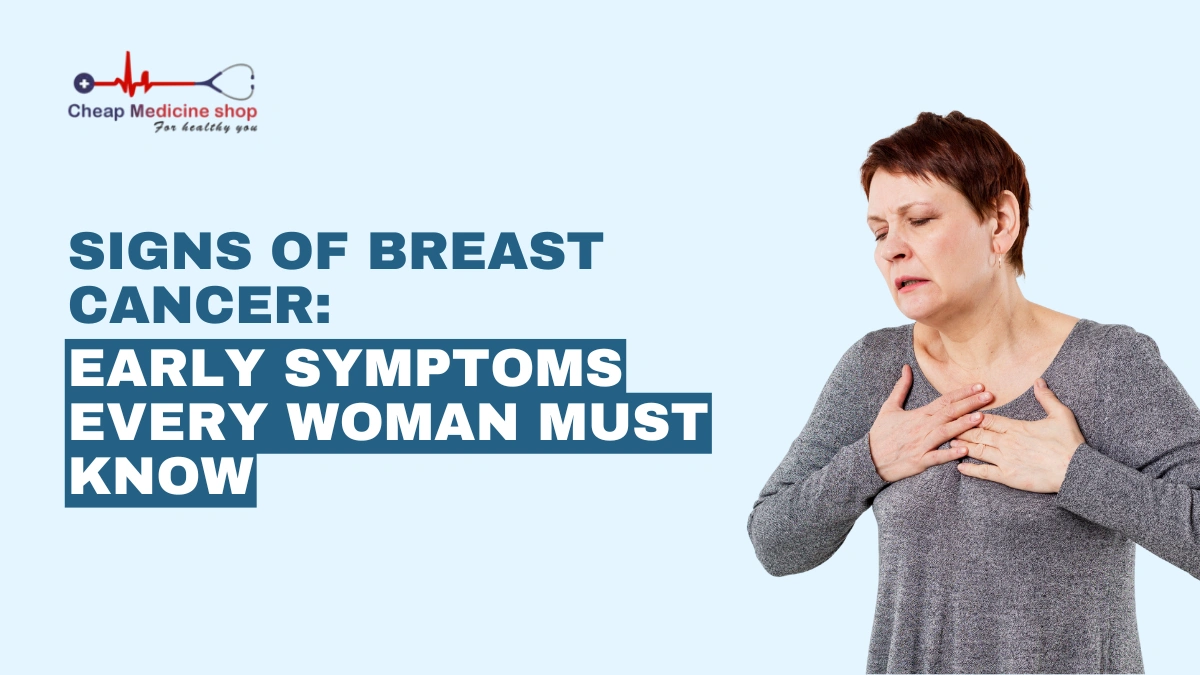Breast Cancer is one of the most common Cancers affecting women, and in rare cases, men. It develops when breast cells grow in an abnormal and uncontrolled way, often forming a lump or spreading to nearby tissue.
Early signs can include a painless lump in the breast, changes in the shape or size of the breast, or nipple discharge that isn’t related to breastfeeding. Spotting these symptoms matters because treatment is usually more effective in the earliest stages, and the chances of recovery are much higher.
According to the World Health Organization (WHO), Breast Cancer accounts for nearly one in every four Cancer cases among women worldwide. Knowing what symptoms to watch for helps you take action quickly and seek medical advice without delay.
In this article, we’ll walk through the most common and less common signs of Breast Cancer, simple self-check methods, and when to reach out to a doctor.
Most common signs and symptoms of Breast Cancer
The earliest Breast Cancer signs are often visible or felt in the breast or nipple area. Let’s know the most common ones in detail.
Save up to 90% on your medicine bills

Abraxane 100 Mg Injection

Alphalan 5 Mg Tablets

Adriamycin 50 Mg Injection

Abirapro 250 Mg Tablet
Lump or swelling
A lump in the breast is the most well-known sign of Breast Cancer. Most lumps are painless, firm, and have irregular edges, though some may be tender or rounded. These lumps occur due to abnormal growth of breast cells that clump together and form a mass.
Sometimes, swelling can also appear in the underarm or around the collarbone if Cancer spreads to nearby lymph nodes. Not every lump is cancerous; it could also be a benign cyst. However, it’s important to have any new lump evaluated by a doctor to ensure the proper diagnosis.
Skin changes
The skin over the breast can also show signs that something is wrong. Sometimes, these changes are visible even before a lump is felt, making them important warning signals to pay attention to.
- Dimpling or puckering: When Cancer cells block lymphatic vessels (tiny tubes that carry fluid and waste out of the body’s tissues), fluid can build up, causing the skin to dimple, much like the surface of an orange.
- Redness or orange peel-like texture: Inflammatory Breast Cancer, a rare but aggressive type, often presents with redness, warmth, and thickened skin resembling an orange peel.
These skin changes may be mistaken for infections or allergic reactions, so medical evaluation is essential.
Changes in breast size or shape
Sudden or uneven enlargement of one breast can be a warning signal. Abnormal tissue growth may stretch the skin or alter the breast’s natural contour. Such changes are usually noticeable when comparing both breasts in the mirror.
Nipple changes
Along with breast lumps or skin changes, the nipple is another area where early warning signs of Breast Cancer can appear. Paying attention to the following changes is essential, as they are often overlooked or mistaken for minor skin or hormonal issues:
- Inversion or pulling in: A nipple that suddenly turns inward may indicate that underlying cancerous tissue is pulling it inside.
- Rash or irritation: Persistent rashes or crusting around the nipple can resemble Eczema but may actually be linked to a rare condition called Paget’s Disease of the breast.
- Pain or unusual discharge: While nipple discharge can occur for many reasons, bloody or clear fluid not linked to breastfeeding may indicate Breast Cancer.
Less common symptoms to watch for
Not every symptom is obvious or directly linked to the breast itself. Here are some less common but important signs:
Skin and nipple issues
Persistent thickening, ulceration, or changes that don’t improve with routine care may suggest deeper tissue involvement. These issues are often overlooked because they resemble minor skin infections.
Persistent pain
General breast pain is often hormonal, especially around menstrual cycles, also called cyclic breast pain. But sharp, localized, or constant pain in one area that doesn’t go away could be a warning sign. Pain alone is not usually a sign of Cancer, but if it happens with other changes, it should not be ignored.
Changes in the lymph node
Breast Cancer can spread to lymph nodes located in the underarm or near the collarbone. You may notice swelling, tenderness, or small lumps in these areas before finding any changes in the breast itself.
Systemic changes
In advanced stages, Breast Cancer may cause overall symptoms such as fatigue, weight loss, or bone pain. While these are not early signs, they highlight the importance of detecting Cancer before it spreads.
Symptoms that may not be Cancer
It’s important to remember that many breast changes are not cancerous. Hormonal fluctuations, infections, benign cysts, and fibrocystic breast changes (a common non-cancerous condition where breasts feel lumpy, tender, or painful) can all mimic Breast Cancer symptoms. For example:
- Lumps may be due to fluid-filled cysts.
- Breast tenderness is often linked to menstrual cycles.
- Skin infections like Mastitis can sometimes cause redness.
Even so, because these symptoms overlap with Breast Cancer signs, a doctor’s evaluation is always the safest option.
How to check your breasts
Knowing the normal look and feel of your breasts makes it easier to notice changes early. Self-examination is not a replacement for medical screening but a simple way to stay alert.
Self-examination tips
When doing a self-check:
- Stand in front of a mirror and look for changes in size, shape, or skin texture.
- Raise your arms and observe if the breasts move or look different.
- While lying down, use the pads of your fingers in a circular motion to feel the entire breast and armpit.
- Repeat while standing or in the shower, when the skin is slippery, and changes may be easier to detect.
The TLC approach
A helpful way to remember breast self-checks is through the TLC approach, which is:
- Touch your breasts regularly to check for lumps or unusual thickening.
- Look for visible changes in the mirror, such as skin dimpling or nipple inversion.
- Check with your doctor immediately if you find anything unusual.
When to see a doctor
Any lump, persistent pain, or change in the nipple or breast skin should be reported to a healthcare professional. You should also see a doctor if you notice:
- Bloody or unexplained nipple discharge.
- Persistent swelling in the armpit or collarbone area.
- Skin changes that do not improve with creams or antibiotics.
Remember, early consultation not only rules out Cancer but can also detect mild conditions that need treatment.
Conclusion
Awareness of the signs of Breast Cancer is one of the most effective steps for early detection and protecting your health. Common symptoms like lumps, skin dimpling, nipple inversion, and unusual discharge should always be taken seriously.
At the same time, less common signs like lymph node swelling or persistent pain can also be important indicators. Not every change means Cancer, but awareness and timely medical check-ups can make all the difference.
Regular self-checks, medical screenings, and open discussions with your doctor are the best ways to stay ahead and ensure peace of mind.
Frequently Asked Questions
What are the signs of Breast Cancer with implants?
Breast Cancer in women with implants can present similarly to natural breasts, including lumps, changes in breast shape, nipple discharge, or skin dimpling. Implants may make lumps harder to feel, so regular self-exams and routine imaging like mammograms or ultrasounds are essential for early detection.
What are the signs of Metastatic Breast Cancer?
Symptoms of Metastatic Breast Cancer depend on the affected area. It may include persistent bone pain, shortness of breath, unexplained weight loss, severe fatigue, or neurological changes such as headaches or vision problems, indicating the need for prompt medical evaluation.
Does Breast Cancer hurt in the early stages?
No, early-stage Breast Cancer usually does not cause pain. Many women first notice a painless lump or minor changes in breast size, shape, or skin texture. Some may feel tenderness or discomfort, but pain alone is rarely an early warning, making self-exams and screening crucial.
Which side is Breast Cancer more common on?
Studies suggest Breast Cancer occurs slightly more often in the left breast than the right, though the difference is negligible. Both breasts are at risk, so regular self-checks, mammograms, and awareness of any lumps, changes, or unusual symptoms in either breast are important.
Cheap Medicine Shop only refers to credible, authoritative sources for our content. If you’re curious about how we ensure the integrity of our content, we encourage you to read our Content Information Policy.












